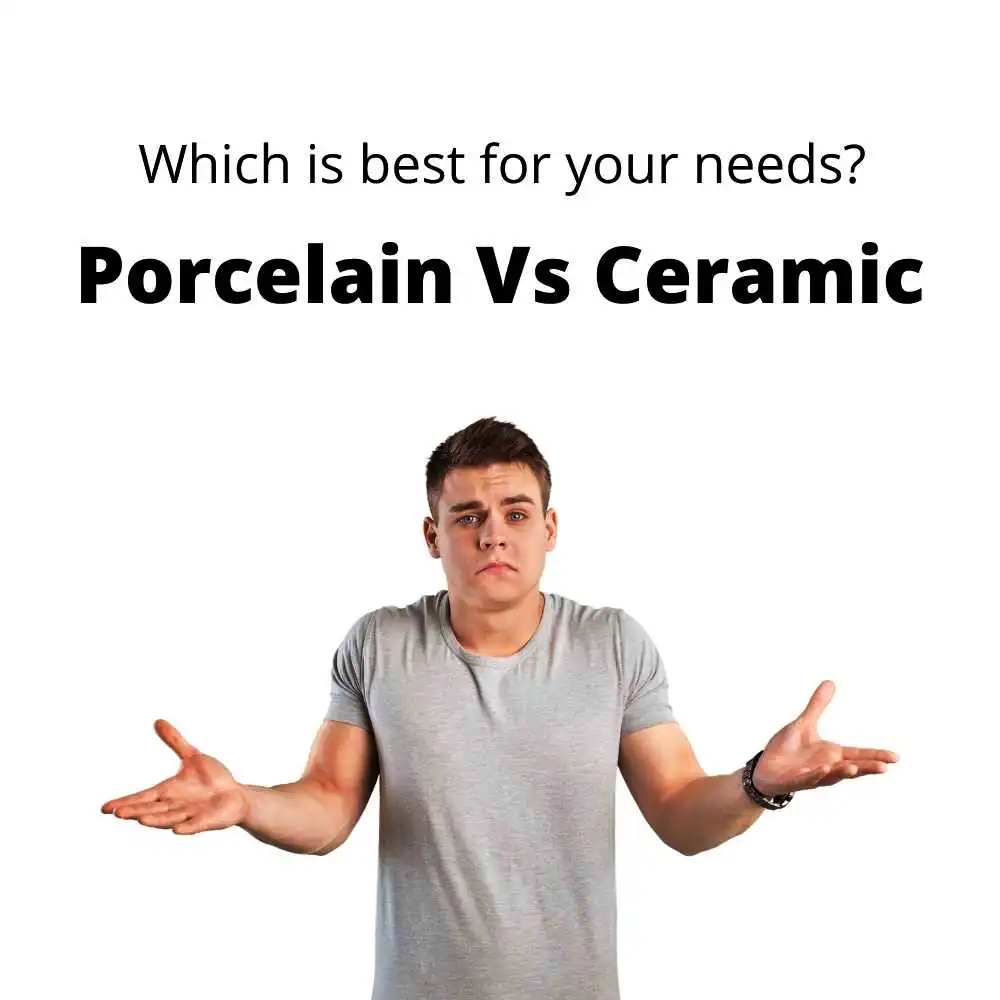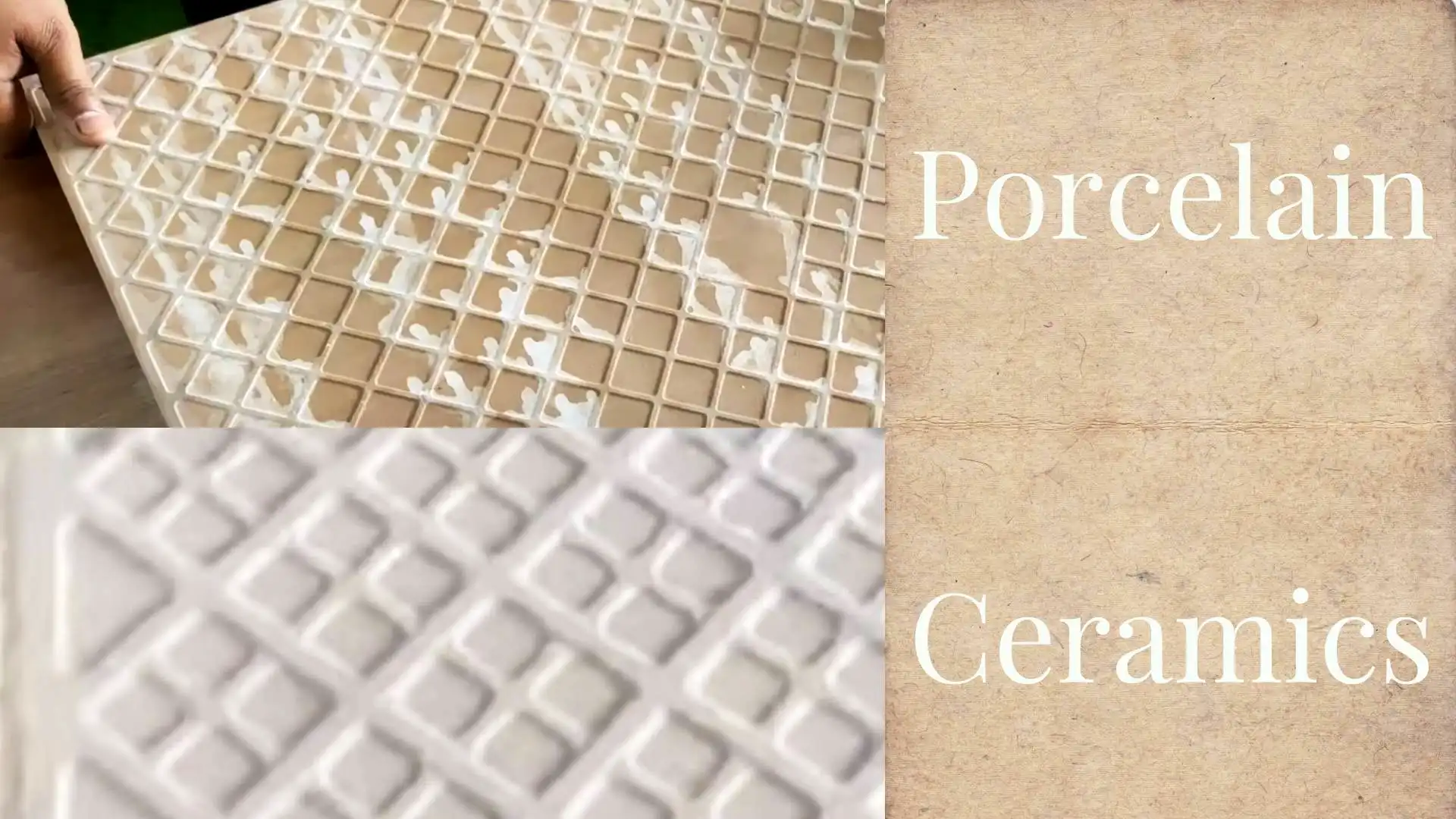So let’s begin understanding the fundamental differences between ceramic tiles and porcelain tiles. “Ceramic” in this article context refers to Basic ceramic porous Wall tiles for kitchen backsplash or bathroom wall tiles.
Understanding Keypoints
1) Simple identification technique :
Porcelain Tiles: On the Backside of Porcelain tiles, the body has a slight reddish tint color look & is denser. It takes 10-15 mins to absorb water due to the high dense body but leaves a watermark in the front side appearance. It will take time to dry off that watermark but eventually will go away in 2-4 days. Its weight is also heavier, like a hard stone compared with Ceramic Tiles per square foot.
Ceramic Tiles: Ceramic Wall Tiles are highly porous tiles specifically made to stick to the wall surface. Hence has a high absorbing capacity to hold water to give a better strength to stick with the wall. These are lighter in weight when compared with Porcelain tiles. These are generally soaked in water for 4 hrs before applying to the wall for best results.
Pro-Tip: Finding out better quality? Then ask for size availability depending on thickness.Mostly, try to choose higher thickness for the glaze and body layers for extended-lasting usage. It may cost you a bit higher, but worth every single penny.
2) Material type:
Ceramic: It’s made of various clay like bentonite and kaolin, which are mixed in ceramic body with silica as filler. Ceramic tiles will vary in composition depending on the manufacturer’s recipe for making tiles.
Porcelain: Its made up of Kaolin Clay, also known as China Clay, has low plasticity. Hence, it has a white/grey body look, which means how flexible a clay is when the force applied by the Press machine on clay will not change its shape. So we can call it a rigid clay particle.
3) Manufacturing Process:
Porcelain: As it’s denser and heavier than Ceramics, it requires more time to get baked into the kiln for High temperatures at a slow pace.
Ceramic: It has a fast manufacturing Cycle process, and baking time is less in the kiln at 1200 Degree Celcius.
4) Design Type:
Porcelain tile & Ceramic Tiles: Mostly Used for walls in kitchen as backsplash and Bathroom has a vast collection. It Comes in various Finishes, which can mimic the look of any natural-looking surface like stone or brick. It’s available in a glossy, matte, anti-slip surface finish.
5) Durability:
Porcelain: Generally, apply Porcelain in low traffic as glossiness/shiny finishing of tiles wears off, but if it has a high thickness of glaze material on top, it may not wear off quickly. That said, It’s more strong as its denser and Heavier.
Ceramics: These are weaker than Porcelain as they are less dense, making them weaker in structures. So applying it on Kitchen walls or any wall makes them perfect for durability.
6) Water Resistivity:
Ceramics: Ceramic absorbs water more easily and quickly due to its porous nature.
Porcelain: It is dense and makes it difficult for water to penetrate the body but will take time to absorb water as it’s not 100% hard as a rock. It may create a watermark effect on the tile’s design front.
7) Environment Suitable: Hot or Cold?
Porcelain Tiles are Weather Resistance as no water gets absorbed. This will prevent tiles from further cracking or breaking.
Ceramics Tiles with high porosity fail to bear extreme temperature as it has impacts due to water absorbing nature, making them prone to thermal expansion and contraction changes.
Tip: You can find ceramic tiles below 3% of water absorption in the vitrified body.
8) Trimming Tiles:
Compared with ceramic tiles, porcelain tiles are hard to cut due to their density. You may check out tools used in tiles trimming.
Buy TILE CUTTING Tool here: https://amzn.to/3i6WIJN.
9) Pricing Cost:
As described in the manufacturing process, porcelain tiles start at higher pricing and are different from ceramic tiles.
10) Directory: Where can you find near your area?
You can use Google Maps or head directly to Ceramic Directory: http://directory.starkmineral.com/.
Conclusion
Both ceramic and Porcelain have their benefits and disadvantages. If you are looking for low pricing, then go with ceramic tiles. If you want long and durable water resistance tiles, choose porcelain tiles. Depending on your location and weather, find your suitable need after learning from this article.
Helpful Resource Book Link – https://amzn.to/3i6WIJN
Want Pro Tips? Here are some listed below. Check out this
Which is Strongest Tiles?
– Go with Full Body Ceramic tiles because these are strong and similar to Granite or Marble stone.
Below is the list from high strength to low strength:
Full Body Tiles > Double Charge tiles > Porcelain >Nano single charge Tiles
What are other Alternatives?
Try anti-skid tiles if you use them in a wet area like a Bathroom. These are anti-slip tiles with texture helping to have a better grip.

